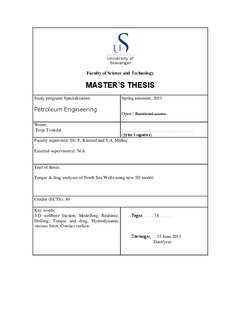| dc.contributor.author | Tveitdal, Terje | |
| dc.date.accessioned | 2011-10-29T09:33:56Z | |
| dc.date.available | 2011-10-29T09:33:56Z | |
| dc.date.issued | 2011 | |
| dc.identifier.uri | http://hdl.handle.net/11250/183317 | |
| dc.description | Master's thesis in Petroleum engineering | no_NO |
| dc.description.abstract | Excessive drill string torque and drag is one of the major limitations of extended-reach and horizontal drilling. The torque and drag models are used in the planning phase and during the drilling of a well, as a tool used for monitoring developing hole problems. The models used throughout the industry today are mostly based on equations presented more than two decades ago, little work have been done to improve upon these. The thesis gives a general overview of the various challenges of using such models. It is shown the importance of correcting for friction in the draw works sheaves to get realistic friction factors. A recently published model is used and work has been done to improve this model further. The model has some inaccuracies in the lower part of the string and a new model for drag in the lowest part is proposed. Further is a new criterion presented, for determining whether an element is straight or curved. This new criterion account for radial clearance between drill string and bore hole wall. | no_NO |
| dc.language.iso | eng | no_NO |
| dc.publisher | University of Stavanger, Norway | no_NO |
| dc.relation.ispartofseries | Masteroppgave/UIS-TN-IPT/2011; | |
| dc.subject | petroleumsteknologi | no_NO |
| dc.subject | boreteknologi | no_NO |
| dc.subject | 3-D wellbore friction | no_NO |
| dc.subject | modelling | no_NO |
| dc.subject | realtime | no_NO |
| dc.subject | drilling | no_NO |
| dc.subject | torque | no_NO |
| dc.subject | drag | no_NO |
| dc.subject | hydrodynamic viscous force | no_NO |
| dc.subject | contact surface | no_NO |
| dc.title | Torque & drag analyses of North Sea Wells using new 3D model. | no_NO |
| dc.type | Master thesis | no_NO |
| dc.subject.nsi | VDP::Technology: 500::Rock and petroleum disciplines: 510::Petroleum engineering: 512 | no_NO |
